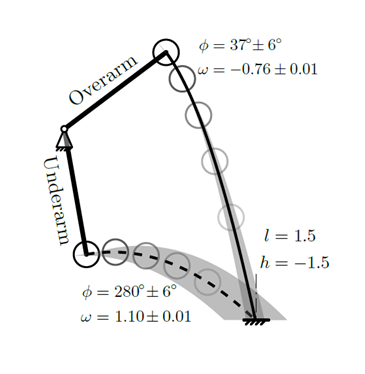Why Physics and Not Biomechanics Determines Human Throwing Accuracy
Here’s a straightforward question. Imagine you are throwing a ball into a bin. Are you better off using an overarm or an underarm throw?

It turns out that this question has been surprisingly hard to get to grips with for physicists and biomechanicists alike. Today, however, Madhusudhan Venkadesan and Lakshminarayanan Mahadevan at Harvard University’s Applied Math Lab, throw some additional light on the problem.
The difficulty is in the complexity of the problem. The arm, shoulder and wrist make up a many-jointed system that allows a large number of variations in throwing style. In addition, the parameters involved in throwing are difficult to compare. For example, a 5 per cent error in throwing angle does not easily stack up against a 5 per cent error in throwing speed because these quantities have different dimensions. It’s like comparing apples and bananas.
Venkadesan and Mahadevan have a neat way round this conundrum. First, they consider only the simplest type of throwing model: an arm consisting of a lever pivoted at the “shoulder” which can throw either underarm or overarm. These throws can be described by two parameters: the angular velocity of the swing and the angle of the arm at release. Second, they introduce a natural length scale, called the arm length, and use this to make their analysis of launch angle and velocity dimensionless.
In this way, they have a simple model in which the errors in launch parameters can be easily compared.
What they find is kind of curious.
Any throw will have small errors in launch angle and velocity. The question that Venkadesan and Mahadevan ask is how different trajectories amplify these errors after launch.
The most interesting result is that there is a clear trade off between speed and accuracy: slower throws are better. That will agree with most people’s experience of throwing and also with the mountain of measured data that already exists on this topic. However, the consensus till now is that slower throws are more accurate because of the limitations of our bodies. The thinking is that the performance of muscles is noisier at higher strengths and this is what reduces the accuracy of faster throws.
So the result of Venkadesan and Mahadevan will come as a surprise because the trade off between accuracy and speed comes entirely from the way the trajectory amplifies errors–muscle behaviour doesn’t enter into it. The result is purely from physics rather than biology.
Venkadesan and Mahadevan have another interesting result which is that when it comes to faster throws, the overarm action is clearly more accurate. That will also chime with many people’s experience but again it has little to do with biomechanics. The result is purely from the way different trajectories amplify errrors.
The work offers some potentially rewarding avenues for sports scientists to investigate the accuracy of throwing in more complex models that better reproduce the mechanics of the human throwing action. That’ll be interesting to watch.
Ref: arxiv.org/abs/1008.1442: Optimal Strategies For Throwing Accurately
Keep Reading
Most Popular
Large language models can do jaw-dropping things. But nobody knows exactly why.
And that's a problem. Figuring it out is one of the biggest scientific puzzles of our time and a crucial step towards controlling more powerful future models.
How scientists traced a mysterious covid case back to six toilets
When wastewater surveillance turns into a hunt for a single infected individual, the ethics get tricky.
The problem with plug-in hybrids? Their drivers.
Plug-in hybrids are often sold as a transition to EVs, but new data from Europe shows we’re still underestimating the emissions they produce.
Google DeepMind’s new generative model makes Super Mario–like games from scratch
Genie learns how to control games by watching hours and hours of video. It could help train next-gen robots too.
Stay connected
Get the latest updates from
MIT Technology Review
Discover special offers, top stories, upcoming events, and more.